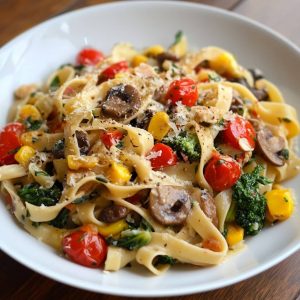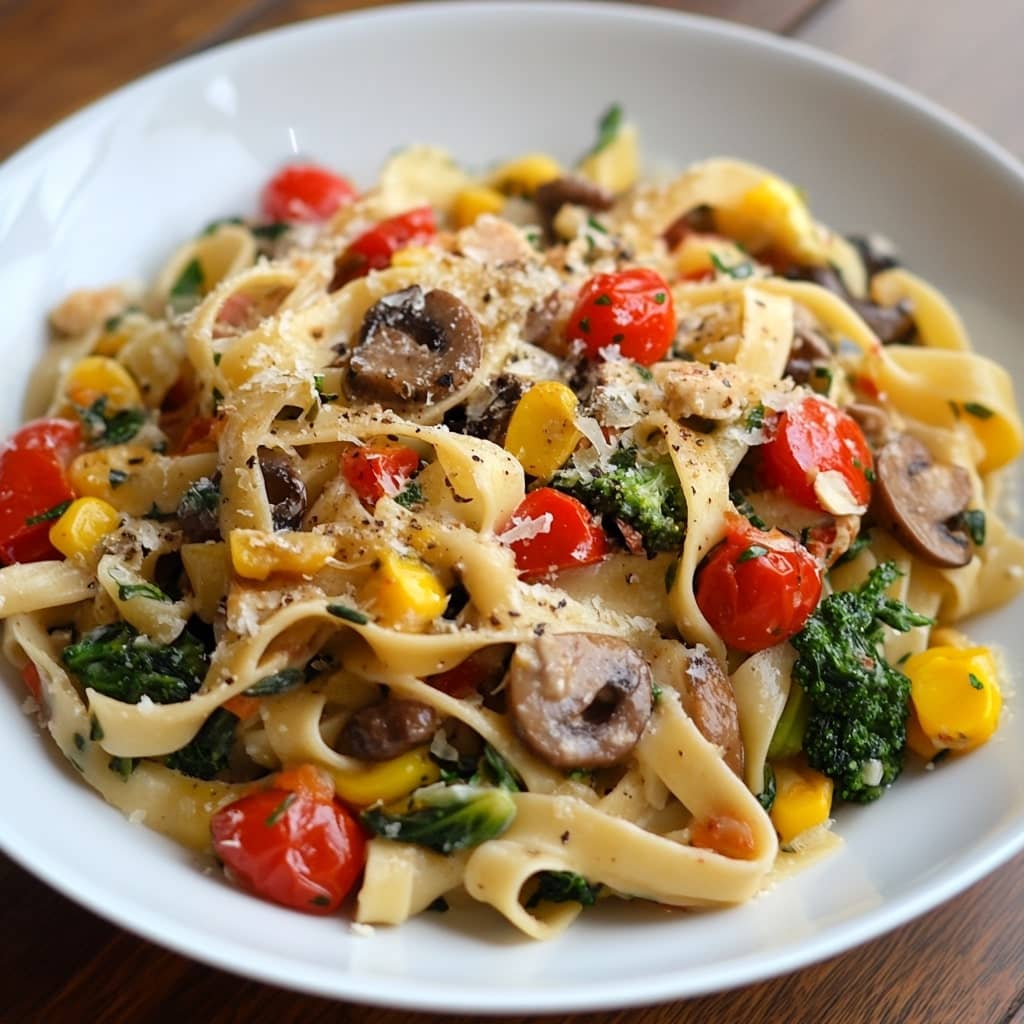Introduction
Pasta Primavera is a vibrant, fresh, and light dish that celebrates the bounty of vegetables, offering a delightful combination of pasta and seasonal produce. The dish is often served with a light olive oil-based sauce, enhancing the natural flavors of the vegetables while adding richness and creaminess. Perfect for spring and summer, Pasta Primavera is a versatile dish that can be enjoyed both as a vegetarian main or a side to a protein-packed meal.
The History of Pasta Primavera
Pasta Primavera originated in North America, despite its Italian-inspired name. It is believed to have been created in the 1970s at the famed Le Cirque restaurant in New York City by chef Sirio Maccioni. The dish was inspired by the vibrant, seasonal vegetables found in Italy but adapted to fit the American culinary scene. It became an instant hit and has since evolved into various regional versions, becoming a beloved classic in both Italian and American cuisines.
Ingredients Breakdown
The key ingredients for Pasta Primavera include pasta, typically spaghetti or penne, and a colorful array of fresh, seasonal vegetables. Common vegetables used in this dish include bell peppers, zucchini, carrots, peas, tomatoes, and asparagus, but feel free to customize with your favorite vegetables. The sauce is typically a simple combination of olive oil, garlic, lemon, and fresh herbs, such as basil or parsley, to bring out the flavors of the vegetables. Parmesan cheese and a sprinkle of salt and pepper finish off the dish.
Step-by-Step Recipe
Start by cooking the pasta according to the package instructions in a large pot of salted boiling water. While the pasta is cooking, heat olive oil in a large skillet over medium heat. Add the garlic and sauté until fragrant, about 1-2 minutes. Add the vegetables to the skillet, beginning with the harder vegetables like carrots and asparagus, and sauté until tender but still vibrant, about 5-7 minutes. Once the vegetables are cooked, add the cooked pasta to the skillet and toss to combine. Season with salt, pepper, and a squeeze of lemon juice. Finish with freshly grated Parmesan cheese and fresh herbs for added flavor. Serve immediately.
Tips for the Perfect Pasta Primavera
To achieve the perfect Pasta Primavera, use a variety of vegetables to create a colorful and visually appealing dish. Be sure not to overcook the vegetables; they should remain slightly crisp to maintain their natural sweetness and texture. When selecting pasta, opt for a shape that can hold the sauce and vegetables well, such as penne or fusilli. For a creamy version, add a dollop of ricotta cheese or a splash of heavy cream to the sauce. To bring out the flavors even more, finish with a drizzle of good-quality olive oil just before serving.
Variations and Customizations
Pasta Primavera is a versatile dish, and there are many ways to customize it based on your preferences. For a protein boost, add grilled chicken, shrimp, or tofu. For a richer sauce, incorporate cream or a splash of white wine. If you prefer a vegan version, skip the cheese and use plant-based alternatives. You can also experiment with different herbs, such as thyme or oregano, or swap in roasted vegetables for a deeper, caramelized flavor.
Health Considerations and Nutritional Value
Pasta Primavera is a nutritious meal packed with vitamins and minerals from the fresh vegetables. It’s also a good source of fiber, especially if you opt for whole-wheat pasta. The olive oil used in the dish provides healthy fats, while the addition of Parmesan adds protein and calcium. To make it even healthier, use a smaller amount of oil and cheese or choose a gluten-free pasta option. This dish is light, flavorful, and can easily be made into a balanced meal by adding protein.
FAQ
- Can I make Pasta Primavera ahead of time?
While Pasta Primavera is best served fresh, you can prepare the vegetables and pasta ahead of time and assemble the dish just before serving. It also reheats well, though the vegetables may lose some of their texture. - Can I use frozen vegetables for Pasta Primavera?
While fresh vegetables are recommended for the best flavor and texture, you can use frozen vegetables if fresh ones aren’t available. Just be sure to thaw and drain them well before adding them to the dish. - Can I make Pasta Primavera gluten-free?
Yes, you can easily make Pasta Primavera gluten-free by using a gluten-free pasta alternative. There are many great options available, including rice pasta and gluten-free penne. - What is the best pasta to use for Pasta Primavera?
Spaghetti, penne, fusilli, and farfalle are all great options for Pasta Primavera. Choose a shape that will allow the vegetables and sauce to cling well.

Pasta Primavera
Ingredients
- 10 ounces penne pasta
- 2 tablespoons extra-virgin olive oil with extra for drizzling
- 4 garlic cloves thinly sliced
- 1 yellow squash cut into thin half-moons
- 1 zucchini cut into thin half-moons
- 1 bunch asparagus chopped into 1-inch pieces
- 1 cup cherry tomatoes halved
- 1 cup red onion thinly sliced
- 1 teaspoon sea salt
- ½ cup frozen peas thawed
- ¾ cup grated pecorino cheese
- 3 tablespoons fresh lemon juice
- Red pepper flakes to taste
- 1 cup fresh basil leaves plus extra for garnish
- ¼ cup fresh tarragon optional
- Freshly ground black pepper to taste
Instructions
- Bring a large pot of salted water to a boil. Cook the pasta according to the package directions until al dente. Drain the pasta and toss with a drizzle of olive oil to prevent it from sticking.
- In a large, deep skillet, heat the olive oil over medium heat. Add the garlic, squash, zucchini, asparagus, tomatoes, onion, salt, and several cracks of black pepper. Sauté for 3 to 4 minutes, or until the vegetables become tender.
- Add the cooked pasta, peas, cheese, lemon juice, and a pinch of red pepper flakes. Toss everything together to combine. Stir in the basil and tarragon, if using.

